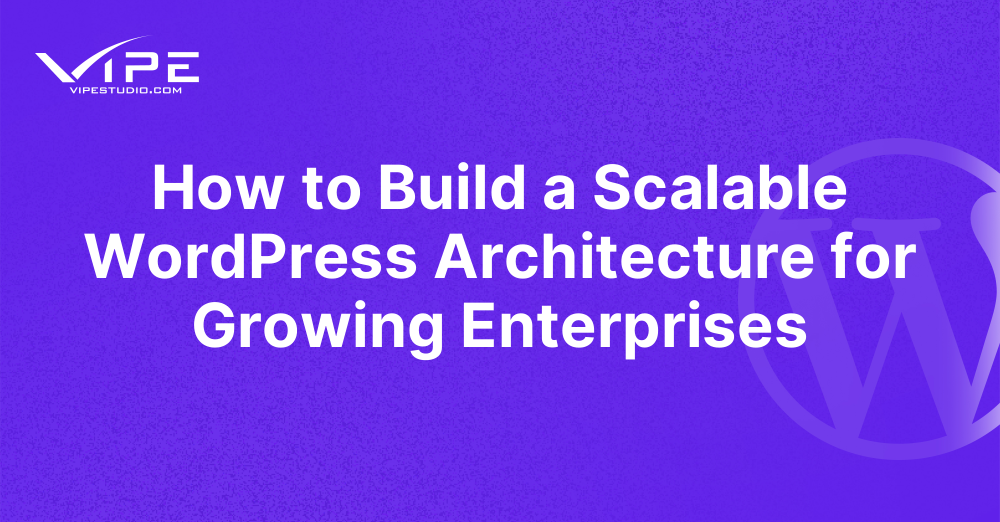23.05.2025
WordPress Development
How to Build a Scalable WordPress Architecture for Growing Enterprises
READING TIME: MIN
Table of Content
As enterprise websites grow in size, complexity, and traffic, scalability becomes a mission-critical consideration. WordPress, when configured properly, can scale impressively to meet the demands of high-traffic websites, complex content workflows, and dynamic data needs. However, it requires deliberate architectural planning and the right development practices from the start.
Why Scalability Matters for Enterprise-Level WordPress Projects
Scalability isn’t just about handling more visitors—it’s about maintaining performance, security, and functionality as your content library, plugins, users, and business logic expand. A non-scalable WordPress setup can lead to slow load times, server crashes, and rising maintenance costs.
- Performance: Fast load times are critical for SEO and user experience.
- Uptime: A scalable setup helps prevent downtime during peak traffic periods.
- Flexibility: A good architecture adapts easily to new features and integrations.
Key Components of a Scalable WordPress Infrastructure
To build a scalable WordPress solution, enterprises need to think beyond basic hosting and plugins. Here are the essential components:
- Modern Hosting: Use cloud platforms like AWS, Google Cloud, or scalable WordPress-specific hosts.
- Object Caching: Implement Redis or Memcached to reduce database queries.
- CDN Integration: Offload static resources via a Content Delivery Network like Cloudflare or BunnyCDN.
- Database Optimization: Regularly optimize tables, use indexing, and separate read/write traffic if needed.
Our team at Vipe Studio has helped numerous enterprise clients set up highly scalable WordPress architectures tailored to their growth goals and operational needs.
Plugin and Theme Management: Minimizing Bloat for Better Scalability
One of the biggest scalability killers in WordPress is excessive or poorly coded plugins and themes. Enterprises should:
- Audit plugins regularly to remove redundancies.
- Use custom-built solutions when performance is a concern.
- Ensure themes follow WordPress development best practices and avoid unnecessary code.
Lightweight, modular development ensures that your platform stays maintainable and fast even as new features are introduced.
Using Headless WordPress to Decouple for Performance and Flexibility
For advanced scalability, many enterprises are turning to headless WordPress. By decoupling the frontend (often built with frameworks like React or Next.js) from the WordPress backend, companies can drastically improve performance, security, and development flexibility.
This approach is ideal for:
- High-performance apps requiring fast client-side rendering.
- Multi-platform content delivery (web, mobile, kiosks).
- Custom dashboards or portals built outside of WordPress themes.
Learn more about headless implementation options at Vipe Studio.
Monitoring and Maintenance: Keeping Scalable Systems Healthy
Even a perfectly designed system can degrade without ongoing maintenance. Enterprises should establish routines for:
- Real-time uptime and performance monitoring (e.g. New Relic, Pingdom).
- Automated backups and disaster recovery planning.
- Security audits and plugin vulnerability scans.
Maintenance should be proactive, not reactive—especially when business operations depend on uptime and speed.
Conclusion: Future-Proofing Your WordPress Infrastructure
Scalability isn’t a one-time task—it’s a mindset and strategy. With the right architecture, development practices, and infrastructure, WordPress can grow with your enterprise. Whether you’re preparing for a global product launch or expanding your services to new markets, a scalable WordPress platform ensures your technology won’t hold you back.
If you’re looking to scale your existing WordPress solution, get in touch with Vipe Studio today to explore tailored solutions for your enterprise.
More on The Topic
- WordPress Performance Debt Nobody Talks About
- The Admin UX That Shapes Decisions
- Scaling WordPress Without Losing Culture
- WordPress 6.9 “Gene”: What This Release Really Changes
- Managing Gutenberg Chaos at Scale
The content of this website is copyrighted and protected by Creative Commons 4.0.



